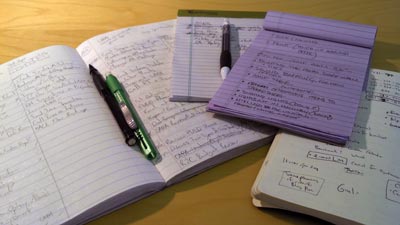To successfully manage projects in a digital strategy agency, you’ll find yourself using various services, programs and techniques to keep track. There is no one ideal solution to deal with the huge amount of information that a project manager needs to stay on top off, and every agency has their own suite of tools that they prefer. Each project manager may also have his or her own methods for organization (and hopefully share those methods with their coworkers, as we do at Metal Toad).
Keeping it all together
What did the developer say about implementing that feature? Did the client want the app background changed to blue or green? When are we going live with that site? Having a central repository for information relating to a project is vital.
Most of our project information lives in Basecamp. We use Basecamp to keep track of files relating to a project, client communication, project timeline, and to-dos. While email can be a great tool for communication, it’s also easy for things to get lost in the shuffle. Not everyone has access to your email, but everyone can have access to a web-based tool like Basecamp. Being able to reply via email rather than logging into the system is a feature our clients love, and most appreciate having an easy way of looking at the status of their project.
Incidentally, we use Basecamp Classic at Metal Toad. While we’ve been exploring the new version of Basecamp and love the new user interface, there are some features that are greatly missed (templates and private messages in particular).
If you are a developer working on a team and you aren’t using some sort of version control, you’re asking for trouble. Subversion and Git are two of the more popular solutions for version control. We use Git via Github to keep track of our code, and have some goodies available in our public repos.
Daily To-Dos and Project Planning
You’d figure for a company that creates incredible technology solutions for our clients, we’d be paper-adverse. Nothing yet beats having a notepad or notebook handy, however. Speed, ease of use, and the ability to easily switch between writing notes or sketching something out, you won’t find any of our project managers without a paper and a pen or mechanical pencil nearby.

As mentioned before, we do also keep to-do lists in Basecamp, mainly for items that we need to share with a group or assign to a specific person. I’m a big proponent of Remember the Milk, and have shelled out the money for the pro version the past few years to have easy access to the mobile app (which is incredibly easy to use). Being able to keep track of things that I need to get done on a platform that works on both a desktop computer and a mobile device, while being able to seamlessly switch between both allows me to stay on track whether in the office, at an off site client meeting, or riding the bus.
Text files are easy to keep track of as well and about as universal as you get on different computer systems, making them a file format of choice for taking notes. Since our notes are documented in Basecamp, we have a tendency to write notes in textile so that we can easily transfer these notes to Basecamp without any fuss.
We’re also avid users of Google Apps, taking full advantage of Gmail, Google Calendar and the new Google Drive. Rather than use Microsoft Office or a similar product, many of us use Google Docs – with the added benefit of being able to easily collaborate in real time.
Time Tracking and Bug Fixing
Keeping track of your time and the time developers are spending on projects is absolutely vital for a project manager. You need know succinctly where a project is going and whether the project’s goals are going to be met, and that’s impossible if you can’t correlate time spent vs. budget. While Basecamp has time tracking built in, we found that it didn’t quite meet our needs, especially when it comes to time reporting. Enter Harvest.
Harvest is a fantastic service for keeping track of time spent on a project. You can easily start and stop tasks within the web interface or through the native app. The reporting functionality in Harvest allows us to easily see how much time is going to certain aspects of a project (project management, development, quality assurance, etc.) and whether we’re on target.
For keeping track of feature requests and bug fixes, Lighthouse is our current tool of choice. Descriptions are written into Lighthouse tickets, and we correlate those ticket numbers with notes in Harvest, so that we can easily track how much time is spent on specific tickets.
Tools are only good if you use them
There are many different tools and services out there to help manage an interactive project, but they are only good if you have buy-in from your team. If a tool isn’t used, there’s no benefit. Find tools that work for you. Introduce them to your coworkers, allowing them to try integration with their own workflow. For example, a member of the Metal Toad team introduced us to Yammer a couple of months ago. We’ve since integrated that within our workflow, allowing us to better keep tabs on what our coworkers or doing during the day.
What do you use to stay organized and make a project successful? Sound off in the comments below.